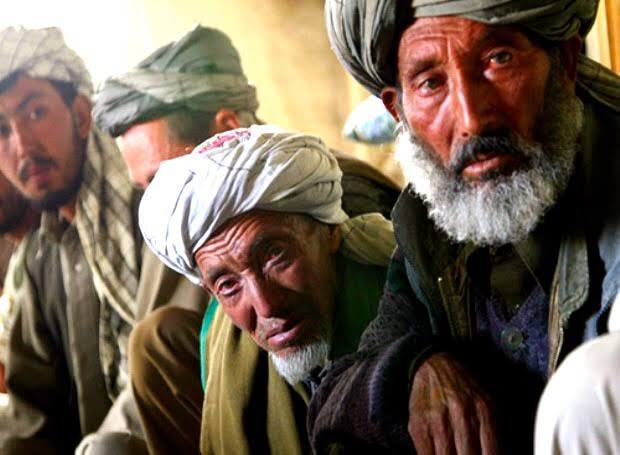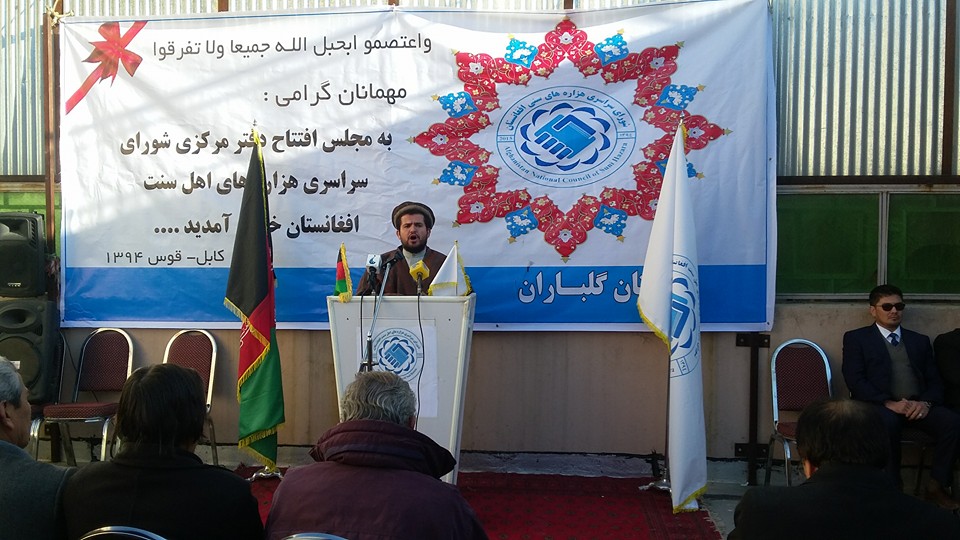Preface:
Sunni Hazaras like their Ismaili brethren have been an integral part of the larger Hazara community in Afghanistan. Painful historical events perpetrated by the former rulers of Afghanistan from the time of the creation of the country as a geographical entity onward especially during the reign of Amir Abdur Rahman who waged a sectarian as well a racial war of genocide against Shi’ite Hazaras created a distance between the two main portions of the Hazaras. Shi’ite Hazaras were overwhelmingly massacred and displaced from their lands in central and south-central Afghanistan. The Sunni Hazaras were largely spared due to their sect of religion as they blended with the local non-Hazara population.
However, self-awareness of the new generation and discrimination and marginalization of the masses of Sunni Hazaras by other ethnic groups even those who were their associates forced them to restore their identity and claim their rightful place in society. To the delight of all Hazaras, the distance between the sects of the population is slowly narrowing and we hope that not in a too distant future the Hazara people galvanize into a whole nation, indivisible by region, sect, politics, and affiliation. (Bolaq)

Hazaras are one of the ethnic groups of Afghanistan that historians and researchers refer their etymology to Khazaria or Khazar (Caspian) that may not be unrelated to the Caspian Sea. The name could also be related to their location with a thousand streams, rivers, and creeks, or a thousand valleys or mountains; and it is said that in Hazarajat (Hazara Region) there were hazar chashmeh (a thousand springs) of savory waters that after the advent of Islam in their place a thousand mosques and a thousand pulpits were built. Likewise, during the era of the ancient kings of Zabolistan (currently Zabol province) Hazara people used to provide a thousand horsemen as their tax to the Royal Army of that time. This could also be attributed to their etymology.
The ancient relics, drawings, and paintings discovered on the walls of the temples and near the Buddha statutes, that date back to the Koshani Dynasty and from the physical features of the statues in Bamiyan, one can deduct that the residents of this district until 2300 years ago had the same facial features as those of the current Hazara people. The Mongolian (Asiatic) features of the Hazaras can be traced back to a time well before the advent of Chinggis Khan (Genghiz Khan) and Tamerlane (Amir Timur) as their reigns were in relatively more recent times.
The Hephthalites who replaced the Kushan Empire (from 425-710 AD), had similar facial and physical features. The impact of the Hephthalites can be traced back to the time when the Turkish words entered in the Hazaragi dialect. Al-Biruni relates the Hephthalites to the Turks of Tibet. He regards the first king of this dynasty that ruled for sixty years as “Borhatigin” or “Boratgin.” The last rulers of the Tigins were the Ghaznavids and were based in Ghazni, ruling approximately 1000 years ago.
After Hephthalites, the southern part of the Oxus river was under the rule of the Central and East Asian Turks that lasted more than 1000 years. Therefore, long before the Mongols, residents of Hazarajat of today were influenced by older Turkic tribes with the Turkish language and the same physical features resembling those of the Mongols. According to French researcher, George Ferriere, Hazaras are the original inhabitants of this region and at the time of Alexander’s invasion, they were living on this land.
Some Afghan and foreign scholars concerning the origin of Hazaras also believe that they are one of the oldest inhabitants of this region. Hazara ancestors relate to Turkic people of Central and East Asia who migrated more than 2300 years ago from North and South of the Hindu Kush mountains to the areas now known as Hazarajat.
Their assertions indicate that the arrival of the Turkic people of Central and East Asia from the North and South of Hindu Kush happened three hundred years B.C. The current Turkish language that we know it as ‘Istanbul Turkish’ is an amalgam of Turkic, Persian, Arabic, English, and French; in which the Hazara lexicon has a special place. Many such words are not in use in Persian. Examples:
| English | Hazaragi | Persian |
| Eyebrow | Qash | Abroo |
| Eyelash | Kerpak | Mejeh |
| Span | Qarish | Vajab |
| Wound | Yara | Zakhm |
| Deep | Chuqur | Aamiq |
| Plastic Shoe | Kaloosh | Kafsh |
| Green | Yashi | Sabz |
| Unit of Measurement (About one meter) | Qulach | Meter |
Also such Hazaragi words as Biqush, Charshambi, Toolgha, Boorgood, Iliea, Alaqughami, Algha, Alghawi, Altamoor, Diltamoor, Qarwana, Payedoos, Qaghoosh, Gazma (of the infinitive, Gazmak), Biaqoosh and many such other words.
This has strengthened the position of those researchers who believe in a Turkish ancestry of Hazaras and as such, question many historical assumptions and imaginations.
Theodorson has defined a tribe in his New Dictionary of Sociology as a group with common cultural traditions, and feelings of identity that distinguish the group as a subculture of a larger community, and members of each ethnic group are distinct from other groups in society due to their specific cultural features.
The Hazaras, on one hand, have an ethnic and on the other an ancestry identity. According to this identity all the Hazaras of the world be it Shi’ite, Sunni and Ismaili are classified as Hazaras. Therefore, the Hazaras of Panjshir, Badakhshan, Farkhar, Takhar, Kunduz, Laghman, Balkh, Baghlan, Parwan, Ghore, Badghis, Herat, Taimeni, Jamshidi, Firoozkuhy, Chahar Aimaq, Farah, Helmand, Kandahar, and Uruzgan who are now predominantly Sunnis, are all ethnically Hazaras.
On the other hand, the Hazaras share a common cultural identity. The ethnic Hazara group comprising of Shi’ites, Sunnis, and Ismailis, have a common language and dialect, customs, traditions, lifestyles, and a common social behavior that could have been brought by common ancestry or other social factors. Therefore, an ethnic group can be at the same time a cultural community as well.
The Sunni Hazaras comprise a large portion of the Hazara community. Their religious identity in Afghanistan —like the Shi’ites of Ismailis and the Twelvers— is part of their cultural and ethnic identities, although due to the policies of suppression, censorship, and elimination the Hazaras were known by the world as Shi’ite Hazaras and were ignorant of their other religious identities.
During the last one hundred years, the Sunni Hazaras had little relationship with the Hazaras of Hazaristan and they were hidden among other ethnic groups. Their ethnic identity was intentionally or forcefully ignored.
In demographic statistics, the Sunni Hazaras were classified as Tajiks or Pashtuns. Because after the massacre of the Hazaras by Amir Abdul Rahman, and their successive rulers after him, being a Hazara had become a “social stigma.” And therefore, some of the Sunni Hazaras to escape from the society’s negative attitude and behavior, denied their ethnicity to be safe and were regarded as Tajiks and Pashtuns so that with the change in geography and religious coverage somehow be immune from curses, wrath, slavery, insults, and humiliations that the Shi’ite Hazaras faced daily. Persian language and the Hanafi sect of religion shared amongst Sunni Hazaras and Tajiks were the reasons for their unity and change of cultural identity and ethnicity of Sunni Hazaras.
During this era of history, the Sunni Hazaras renounced their cultural identity and forced to adopt the Sunni sect of religion and identity of Tajiks and Pashtuns to the extent that people of several villages in the central Bamiyan still live with fabricated identity and names.
Sunni Hazaras are still threatened by the anonymity and suppression of their identity. Some Hazaras that have adopted other identities so that they can survive under the guise of another identity, sadly are not safe even under this cover either and have never reached the situations they deserve.
Bigotry and ethnic discrimination in Afghanistan have forced Sunni Hazaras at certain times to stand against and fight the Shi’ite Hazaras; however, now the Sunni Hazaras have realized this and are trying to return to their lost identity and do not name themselves as Tajiks. Unfortunately, the word Hazara is still a taboo amongst Sunni Hazaras. It will take years to lessen the shame and stigma of being Hazara amongst the masses of Sunni Hazaras, and their self-confidence in their identity is rebuilt.
Cohesion and ethnic unity, fight against rampant alienation in the Sunni Hazara community, and defending their rights can lead them to appear in political interactions and proudly regard themselves alongside the other tribes as part of the Hazara community.
Although half of the Hazaras are Sunnis, still they have not returned to their tribal and ancestral identity. After centuries of silence, they must raise their voice with authority against deprivation and alienation from one another.
Unfortunately, the Sunni Hazaras have extensively been “unknown soldiers.” From now on, serious attempts must be made not to be used as peshmerga and leverage. The Hazaras must stand firm and united inclusive of Shi’ites (Ismailis, and Twelvers) and Sunnis, as being one ethnic group and strive to reach their goals.
For Sunni Hazaras, becoming Tajik was a way to gain social worth and somehow share in the political power. Being Tajik was to escape from the same social insult that Shi’ite Hazaras suffered from. People of other tribes would not eat with Hazaras and children of Hazaras were deprived of education and schooling. Maybe this was another reason why the Sunni Hazaras became Tajiks. Another reason why Sunni Hazaras became Tajik can be due to their historical fear. Security was paramount for them and they were fearful of massacre and this has been their perpetual and historical fear.
The Sunni Hazaras have emerged from the heart of the history, a history full of obvious injustices, negligence, marginalization, and violations of rights, a painful history in which their physical features of flat noses and slanted eyes have been subject to constant ridicules and their ancestry, tribal and human identities were distorted.
The Sunni Hazaras were good fighters in battlefields but in the distribution of power, developmental, and welfare resources they were always ignored and kept deprived. Their residential areas are remote valleys that did not receive any development and are still deprived.
The National Council of Sunni Hazaras of Afghanistan came to be as a result of historical suffering and pain of the people who nearly 200 years ago were displaced because of suppression and tyranny of the rulers of the time in Kandahar and Kabul and forced to settle and engage in agriculture in north and west of today’s Afghanistan.
In these places, due to shared religious beliefs, they intermarried with Pashtun, Tajik, and Uzbek ethnic groups. Despite that, the Hazaragi facial features have not been lost, although, they have become slightly different from other Hazaras in terms of their traditions, clothing, and beliefs in their identity.
Hazaragi dialect is still dominant amongst Sunni Hazaras, but out in the open and at the national level they are still considered as Tajiks.
If it were not for the formation of the National Council of Sunni Hazaras, the Sunni Hazaras would have ceased to exist, and no one in the young generations would recognize the Sunni Hazaras.
Sunni Hazaras are a major portion of Hazara people, as we read from the “Wikipedia Encyclopedia” that: “there are a considerable number of Sunni Hazaras that mostly reside in the Centre of the Badghis province in the town of Qala Naw.” Additionally, there are Sunni Hazaras also living in Badakhshan, Takhar, Balkh, Samangan, Baghlan, Parwan, Badghis, Kunar, Logar, Nangarhar, Uruzgan, Laghman, Kabul, Bamiyan, Ghore, Kandahar, Helmand, Farah, Herat, and other provinces.
According to a six-year study of information by the National Council of Sunni Hazaras of Afghanistan and estimated statistics, one can say that the Baghlan province has 16 provincial districts of which 9 are populated by the Hazaras. As such the Sunni Hazaras comprise most of the population of these districts and are from tribes like Saka, Dahla, Gary, Kuhgaday, Kavi, Abka, Chakir, Nokar, Nikpay, etc.
Baghlan is the largest province in which Sunni Hazaras live and co-exist with the Ismaili and Jafari Shi’ites. However, they have never been appointed to the positions of governor, head of national security, or police commander. Aside from Baghlan, Sunni Hazaras are a major part and probably the majority of the residence of the Badghis province who live predominantly in Qala Naw.
In Konduz province, the Sunni Hazaras constitute a considerable portion of the districts of Khan Abad, Ali Abad, and in several other provincial districts. In Takhar province, the Hazaras make more than half of four provincial districts of Namakab, Chal, Ashkamash, and Taloqan.
In Badakhshan province, Sunni Hazaras live in five provincial districts. Approximately half of the population of Ghore province are Sunni Hazaras who consider themselves as Aimaqs. The Sunni Hazaras in Panjshir live mostly in the provincial district of Dara Hazara that probably comprises 20 percent of the population of the province.
In Parwan province, Sunni Hazaras live predominantly in the provincial districts of Sorkh-o-Parsa, Siahgerd, and Ghourband. They are a considerable number and are mostly involved in the trade. In Kapisa, Bagram, Ghazni, Laghman, Bamiyan, Samangan, Dara Shomali, Paghman there are Sunni Hazaras but with varying population densities. In Kabul, the Sunni Hazaras live predominantly in District 315 and they are called Baghal Hazaras. Also, many thousand families of Sunni Hazaras are residing in Qala Chardehi, Qala Fathullah, Murad Khan, Aladdin, Qorgha, Qazi District, Qala Fotooh, Tangui Masnad, Tangui Lander, Kariz Mir, Deh Meskin. This geographic spread and population density show that probably four million Sunni Hazaras live in Afghanistan.
The creation of a center for Sunni Hazaras was initiated during 2014 and also in years before that, albeit at a smaller scale. The first attempt to address the identity of the Hazaras people was by Mowlawi Salikzada former governor of Balkh and Advising minister advisor of the president of the republic and former senator, Dr. Younos Sakaee, professor, and Professor Saeed, both of Kabul University and some others. With the knowledge of the existing conditions, they organized sessions on the identity of Sunni Hazara. During this period, the emphasis was more on the name of this movement. Eventually, in pursuit of these efforts the “Turanians Council” was formed. However, the name and the actions remained in those circles and were not made public. The reason was the suspicious assassination of a member of this group at the Zarnegar Park in Kabul which sounded an alarm bell to the others, and they all fell silent.
Mowlawi Salikzada left the group due to a cool response by the Hazara and Tajik leaders as a result of being Hazara. When he was elected a senator, outside his ethnic affiliation, he claimed to be of Turkic origin and befriended General Dostum and the “Turanian Council” did not materialize.
In 2014 with the presence of the young people in social media and communication through unorganized group meetings, the initial intellectual framework of a council was formed under which the Sunni Hazaras can find their identity. This council was under the leadership of people such as professor Toghyan Sakaee from Baghlan province, Alhaj Gulam Sakhi Parsaee from Parwan province, Abdul Rahman Ranmani, Atiqullah Qaderi, Dr. Meskin Kawi, Dr. Mehrabaddin Shirzad, Mohammad Zobair Falakpoor, Ahmad Bahman, Baba Qaderi, Reza Habibi, Abdul Baset Wahedi, Rafiullah Walizada from Baghlan province, Sami Daraee, Masjedi Saleem from Panjshir, Gul Ahmad Anwari from Ghore province, Sarajaddin Badakhshi, from Badakhshan province, Ishaq Kayhan, Mohammad Asif Sirat, Sami Rahmani from Takhar province, Mohammad Naim Moallemzada for Badghis province, Matiullah Dehati, Younos Mohtawa from Kunduz province, Abdullah Adil from Laghman formed a group that later became known as “the National Council of Sunni Hazaras.”
At a session of this Group, they mostly worked on the name and they chose from such names as “The Council of Turkish Ancestry People,” “Council of Hazaras,” “The Sunni Council and Association,” “Turanian Council” and eventually “The National Council of Sunni Hazara of Afghanistan” was approved.
The reason for choosing these names was the assumption that in origin the Hazaras are of Turkish origin. In the Constitution of Afghanistan, being a Turk is not regarded as specific ethnicity, and besides, the people of these districts know them as Hazara amongst other ethnic groups and the name of the “council” was important for the expression of the identity of Sunni Hazara people.
There was a common belief by this group that in the same way that the Pashtuns of Kandahar and Tajiks of Herat are Shi’ites, the Hazaras can also be Sunnis.
This council was group managed initially. Each week a chair would be elected that would manage the activities until such time that the group became larger and larger. After a period, professor Sakaee, one of the initial founders of the group was elected as the chairperson.
The council began its activity for the rescue of a large group of people who years ago became displaced from their original residence in Kandahar and emigrated to the northern districts.
The objective of the Council is to break the two centuries of silence and do not allow Sunni Hazaras to act simply as a ballot box for and supporter of the local rulers and khans. The main objective of the council is to free people from their identity crisis ad establish a firm political and social standing for the Sunni Hazaras.


2 Responses
السلام علیکم در مورد هزاره های سنی کشور میخواهم بیشتر بدانم، کمتر افراد از هزاره های سنی اطلاع دارند چرا آنها آشکار نیستند؟ آیا به دری مطالب است؟
قبلاء جای خوانده بودم که ما هزاره های سنی هم داریم بسیاری قبول نکردند که ما نداریم همه شیعه اند، تصادف درین سایت برخوردم ، خواستم بیشتر بدانم آنها هم برادران مان اند
در مورد هزاره های سنی بدانم
Comments are closed.